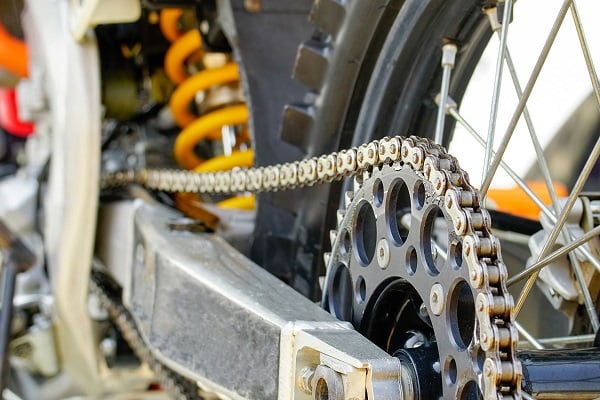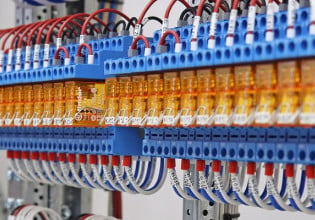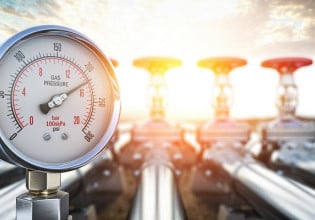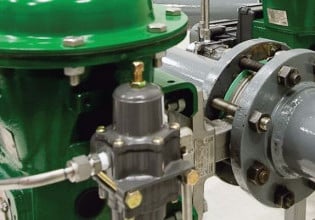The Mechanic’s View of Control: Chain Drive Power Transmission
In the world of mechanical power transmission, gears, belts, and chains dominate the landscape, but what's so special about chain drives, and why would they be used in place of rubber belts?
Mechanical engineers who work around machines are intimately familiar with power delivery through mechanical transmission. Belts, pulleys, gears, and chains are found in every conceivable kind of machine, from nearly microscopic devices to massive assemblies, both of whose manufacturing processes would defy imagination.
Previously, we have investigated both gear drive and belt drive systems. Considering the advantages of each of those dynamics, what benefits might this third category, chain drives, hold that would dictate its use in certain situations?
Chain and Sprocket Interaction
The basic concept of a chain drive system involves the sprockets attached to the rotating shafts, which look a bit like spur gears with rounded teeth. The size of these sprockets, being installed in pairs, both driving and driven, determines the difference in rotational speed between input and output. In that sense, the physical dynamics are studied similarly to gears and belts. Just remember, the larger sprocket always rotates more slowly but with more torque applied to the shaft.
The major distinguishing factor lies in the chain itself, which is the medium that transfers the pulling force from the input (driving) sprocket to the output (driven) side.

Figure 1. The interaction of the driving (left) and driven (right) sprockets shows the force applied only to the pulling side of the chain. Image used courtesy of Control Automation
As the input sprocket begins to rotate, any drooping slack in the chain is pulled tight, but only on the side from which the driving sprocket is pulling. You cannot push a chain. The force that pulls on the chain from the driving gear comes from the torque provided by the driving source, like a motor or steam engine. If the motor produces 100 ft-lb of torque on a sprocket with a 1 ft radius, the pulling force applied to the chain is 100 lb.
This same 100 lb force pulls along the outside radius of the driven sprocket. Assume this driven sprocket has a 2 ft radius. This would result in 200 ft-lb of torque on the driven shaft. The offset of this increase in torque is a 50% decrease in rotational speed, as two full rotations of the input shaft are required for one full output rotation.
Advantages of Chains Over Belts
In a quick review of the physics explained above, it seems striking similar to the math for a belt and pulley system. Indeed, there are many similarities. Unlike gear drives, both belts and pulleys can transfer force over a long distance. They are much more tolerant to slight variations, often equipped with a slotted adjustment or idler. However, there are a few scenarios in which chains display remarkable advantages over belts.
Belt Slippage
At a low RPM, a rubber belt is likely to slip and skip, especially when stopped and started frequently. Since chain links fit down inside matching grooves, they are nearly impossible to slip, unless either severely loose or placed under a torque that is far too great. This makes chains a great choice for power transfer at low RPMs. Since they have no disadvantage at slow speeds, they can handle starting and stopping with ease.

Figure 2. A close-up view of the sprocket clearly shows the curved groove to hold the chain link, preventing slippage under high forward or reverse torque. Image used courtesy of Canva
It would be unwise to say that rubber belts are always at a disadvantage in this case. The argument mainly applies to V and multi-groove V belts. Toothed timing belts share many of the same advantages over those V-shaped rubber profiles.
High-Temperature Environments
When rubber and synthetic belts are exposed to high temperatures and foreign contaminants (usually lubricants), they are far more likely to slip, even at high rotational speeds. Chains, being made out of metal, are immune to most moderate-to-high-temperature environments.
Similarly, they also last far longer than rubber, posing fewer maintenance and unplanned downtime risks. This is why vehicle timing chains do not need to be replaced as often as timing belts.
Disadvantages of Chain Drive Systems
They certainly aren’t perfect, and there are a few considerations that must be designed into a proper solution for chains.
Noise
The metal-on-metal contact of a chain and sprocket will create a lot of noise, and when noise from contact friction is present, heat will also appear. This is often solved by running the chain through an oil bath, both dissipating the heat and muffling the noise. This has no detrimental effect on performance, except that it’s another fluid system to maintain.
Backlash
Although it is nearly impossible to force a sprocket to jump a tooth when stopped, it is not difficult to rotate the driven sprocket just a bit more when the assembly comes to a halt. The force from the chain will prevent any reverse motion, but since the linkages do not fit into the grooves with a tight tolerance (and it gets worse as the system ages), there will be some inevitable slop in the output machine.
If a reverse direction of rotation is required, the pulling side must remove a bit of slack in the chain, so the driving pulley must rotate slightly before the driven shaft begins to move. This causes it to be virtually unacceptable for precise CNC equipment, which will almost always opt for a rubber timing belt that can be easily tensioned into position.

Figure 3. This chain drive for a motorcycle shows a slight droop. If the vehicle is reversed, the slack must be removed before the wheel starts to rotate. Image used courtesy of Canva
Repair Investment
When chain systems break, the problem is far worse than a simple broken chain. In a belt system, you simply loosen the idler pulley, replace the belt, and re-tighten. When a chain breaks from stress or from an external force, the sprockets must be reviewed for any bent teeth. Then, the chain is replaced by repairing a removable master link, or by loosening an idler as with the belt. However, before installation can occur, the input and output must be aligned properly (like the crankshaft and camshaft positions in a car) since they cannot be independently moved after the chain is installed.
Chain Drives: Powerful and Simple
There is no doubt these chain systems are easy to understand for most engineers. You probably first become familiar with chains when learning to drive a bicycle. Despite innovations in belt technology, chains are still an industrial staple, and will likely be seen for many decades due to their simplicity and ability to easily transfer a lot of force under extreme conditions, a constant demand for many industries.
Featured image used courtesy of Canva






